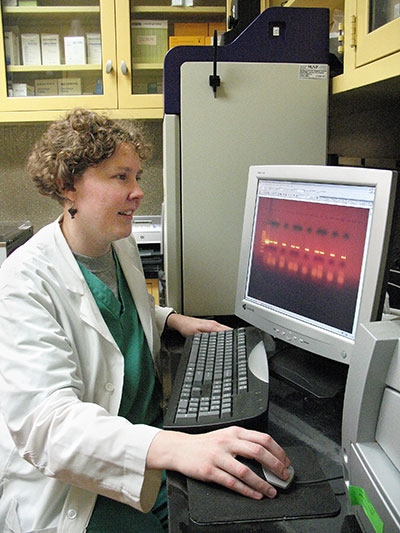
New AI Sampling Method
By Sandra Avant Agricultural Research Service USDA
Features Health Research Poultry Research ResearchMandatory avian influenza testing at processing has gotten simple
 Microbiologist Erica Spackman reviews results of a reverse transcription polymerase chain reaction test to determine whether there is virus in a sample and to generate material for gene sequencing.
Microbiologist Erica Spackman reviews results of a reverse transcription polymerase chain reaction test to determine whether there is virus in a sample and to generate material for gene sequencing. A number of poultry industry groups are using a less costly method to collect avian influenza virus samples, thanks to U.S. Department of Agriculture (USDA) scientists.
At the Agricultural Research Service’s (ARS) Southeast Poultry Research Laboratory (SEPRL) in Athens, Ga., scientists conduct studies not only to identify various avian influenza virus strains, but also to determine their origin and whether current tests and vaccines are effective against them. In addition, the scientists investigate the best methods for collecting virus samples from poultry for testing.
In the United States, all meat chickens and turkeys must be tested for avian influenza before processing. Sample collection is an important component of this process.
A certain number of swab samples, taken from inside the birds’ mouths, are needed per flock to get a reasonable virus sample, according to microbiologist Erica Spackman, who works in SEPRL’s Exotic and Emerging Avian Viral Diseases Research Unit. The current method used to determine if virus is present works well, but requires placing only one to five swab samples in a tube.
Spackman found that improvements could be made by switching the type of swab used and increasing the number or swabs in each tube.
“One of the most important variables is the number of swabs required—the sample size we take from inside the mouth of the chicken or turkey to see if the virus is there,” Spackman says. “We need to collect a certain number of swab samples per flock to get a reasonable virus sample.”
Swab samples are collected from the same flock and put into tubes for testing. Traditionally, each tube contains 1-5 swab samples. The idea was to determine whether more swab samples could be pooled together into a single tube without inhibiting or affecting the sensitivity of the test.
Spackman found that putting 1, 5, or 11 swab samples in the same tube did not affect testing. A similar experiment with Newcastle virus samples had the same results.
This research, which was published in BioMed Central Veterinary Research in 2013, supports the USDA’s priority of promoting international food security.
ARS is USDA’s principal intramural scientific research agency.
Print this page